Secondary Battery Market Size
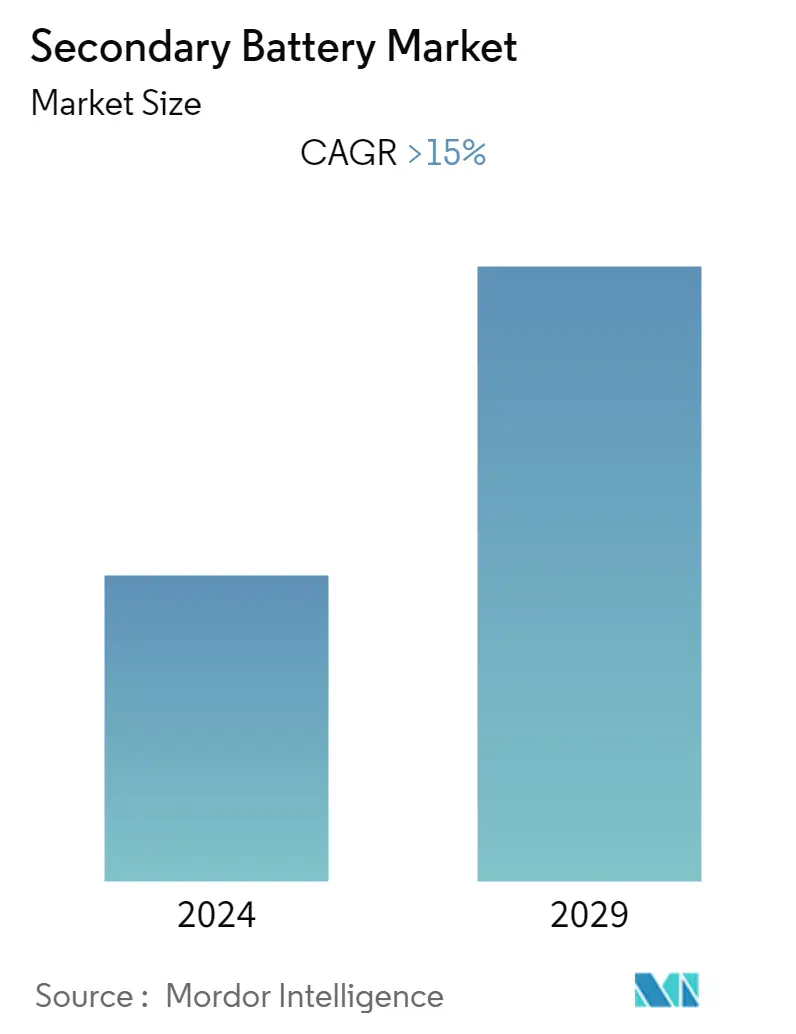
| Study Period | 2020 - 2029 |
| Base Year For Estimation | 2023 |
| CAGR | 15.00 % |
| Fastest Growing Market | Asia Pacific |
| Largest Market | Asia Pacific |
| Market Concentration | Low |
Major Players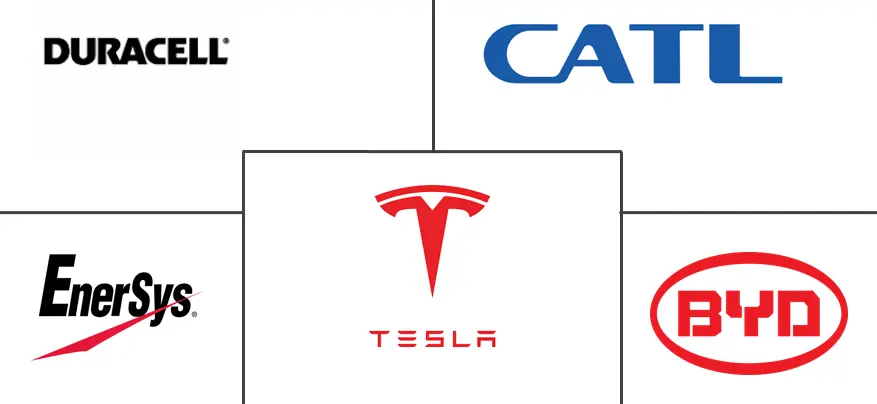
*Disclaimer: Major Players sorted in no particular order |
Secondary Battery Market Analysis
The secondary battery market is anticipated to reach USD 220 billion by 2027, registering a CAGR of more than 15% during 2022-2027.
The market was negatively impacted by COVID-19 in 2020. Currently, the market has reached pre-pandemic levels.
- Over the medium term, declining lithium-ion battery prices and increasing adoption of electric vehicles are likely to be the major factors driving the market.
- On the other hand, the demand-supply mismatch of raw materials is likely to hinder the market's growth.
- Developing new and advanced battery chemistries will likely create immense opportunities for the overall secondary battery market.
- Asia-Pacific is expected to be the largest market, with the majority of the demand coming from China, Japan, and India.
Secondary Battery Market Trends
This section covers the major market trends shaping the Secondary Battery Market according to our research experts:
Lithium-ion Battery Technology to Dominate the Market
- Among different types of battery technologies, lithium-ion battery (LIB) is expected to dominate the secondary battery market in the latter part of the forecast period, majorly due to its favorable capacity-to-weight ratio. Also, other factors that play an important role in boosting the LIB adoption include better performance, higher energy density, and decreasing price.
- Due to its high energy density, the price of lithium-ion batteries decreased considerably from USD 668/kWh in 2013 to USD 123/kWh in 2021, making it a lucrative choice among all batteries.
- Lithium-ion batteries have traditionally been used in consumer electronic devices, such as mobile phones, notebooks, and PCs. However, they are increasingly being redesigned for use as the power source of choice in hybrid and the complete electric vehicle (EV) range, owing to factors such as low environmental impact, as EVs do not emit any CO2, nitrogen oxides, or any other greenhouse gases.
- LIB manufacturing facilities are majorly located in Asia-Pacific, North America, and Europe. Major market players, such as BYD Company Limited and LG Chem Ltd, have plans to set up new manufacturing facilities in the Asia-Pacific region, primarily in India, China, and South Korea.
- Therefore, based on such factors, lithium-ion battery technology is expected to dominate the secondary battery market during the forecast period.
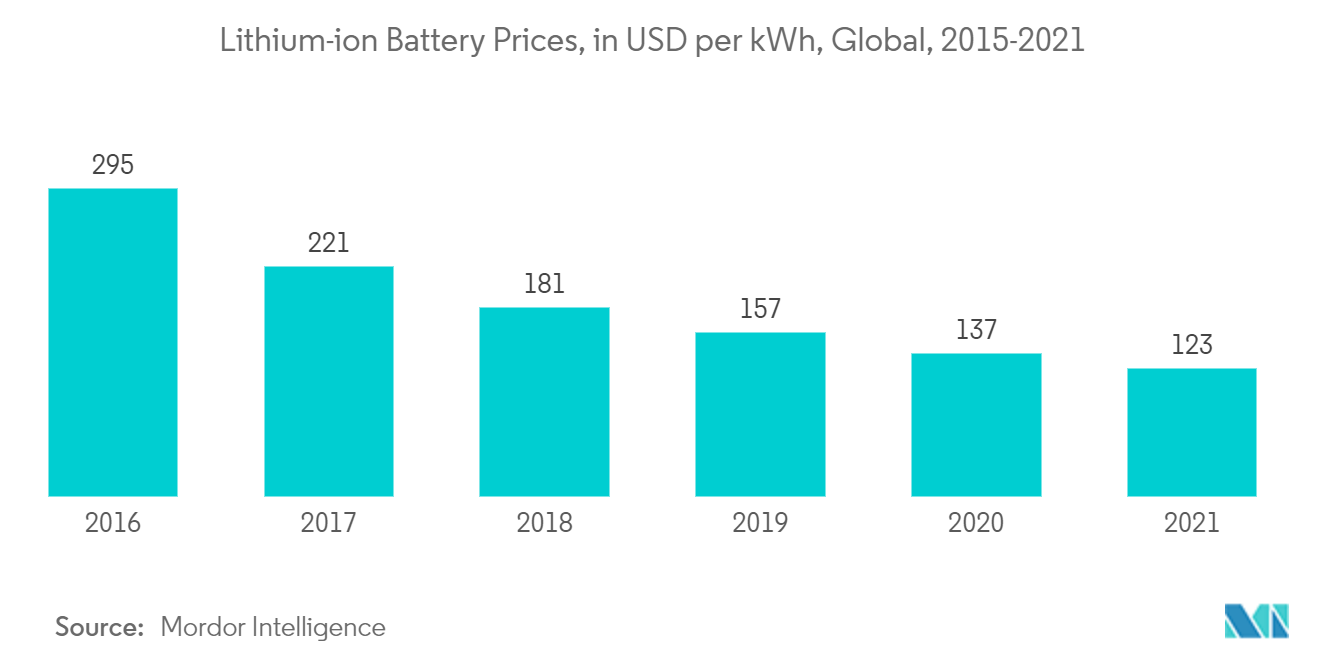
Asia-Pacific to Dominate the Market
- The Asia-Pacific region has multiple growing economies with substantial natural and human resources, with China and India expected to be major investment hotspots for secondary battery companies in the coming years due to policy-level support from governments for both renewables and EVs and a growing middle-class population creating demand for consumer electronics.
- India has been witnessing a surge in manufacturing batteries locally due to the government's push toward e-mobility. The Indian government aims to achieve a 30% electric fleet by 2030 and has been formulating policies and programs to achieve the target. For example, in 2021, the government amended the ongoing FAME-II (Faster Adoption and Manufacturing of Electric Vehicles-II) scheme to increase the subsidy rate for electric vehicles from INR 120/kWh to INR 180/kWh to reduce the gap between petrol-powered two-wheelers and electric powered.
- China was the largest electric car market and sold more than 3.3 million electric vehicles, accounting for almost 16% of the global electric car sales in 2021. It is expected to remain the world's largest EV market in the future. The development of charging infrastructure is further propelling EV adoption in the country. Apart from EVs, the increasing penetration of telecommunication services indicates a high demand for secondary batteries.
- Similarly, in Japan, 5G services started in 2020, and an increasing number of subscribers are likely to switch to 5G during the forecast period, thus resulting in a surge in the demand for 5G towers and secondary batteries.
- Therefore, based on such factors, Asia-Pacific is likely to dominate the secondary battery market during the forecast period.
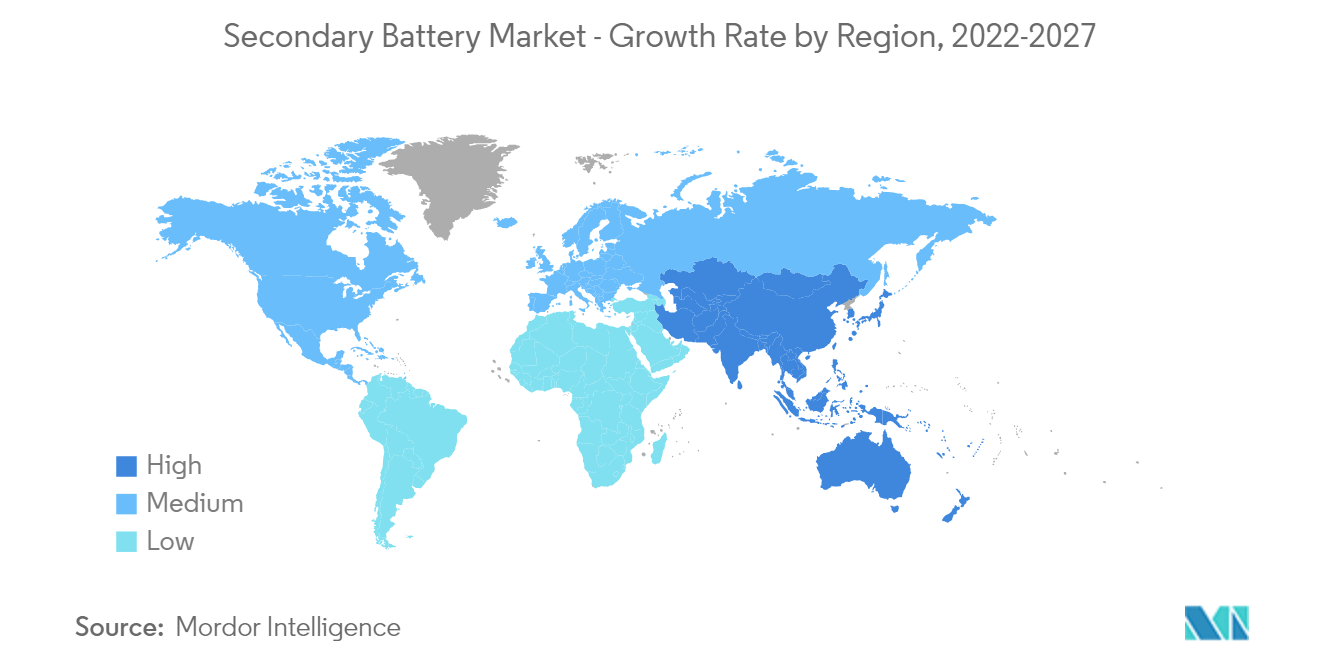
Secondary Battery Industry Overview
The secondary battery market is highly fragmented. Some of the major players include (in no particular order) Contemporary Amperex Technology Co. Limited, BYD Co. Ltd, Duracell Inc., EnerSys, and Tesla Inc.
Secondary Battery Market Leaders
-
BYD Co. Ltd
-
Contemporary Amperex Technology Co. Limited
-
Duracell Inc.
-
EnerSys
-
Tesla, Inc.
*Disclaimer: Major Players sorted in no particular order
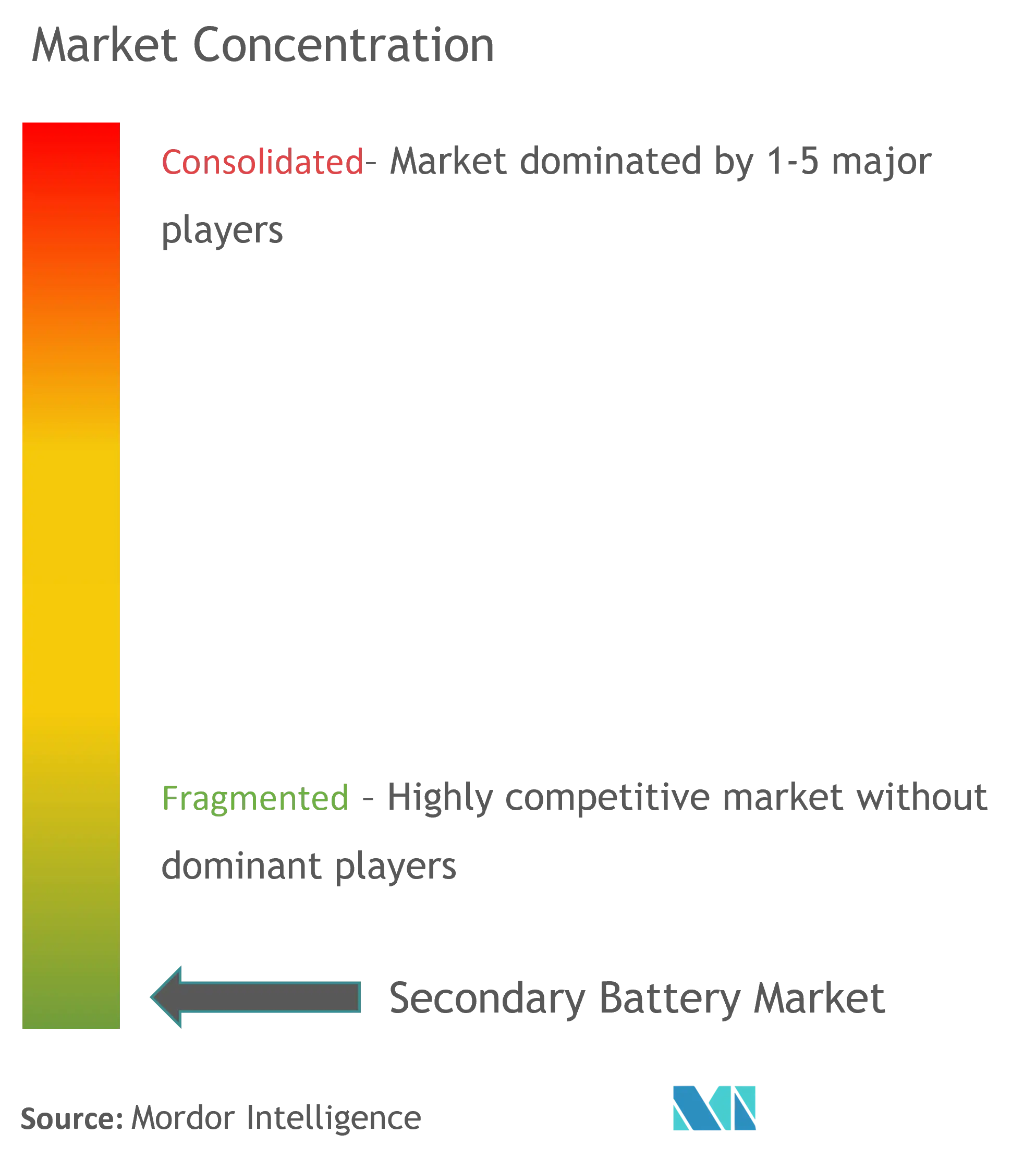
Secondary Battery Market News
- In December 2021, Reliance New Energy Solar Limited entered an agreement with Faradion to acquire 100% of the equity shares for a total value of USD 117 million. Faradion is a UK-based leading battery technology company with an extensive IP portfolio covering many aspects of sodium-ion technology.
- In December 2021, Northvolt produced its first lithium-ion battery cell at its factory in Skelleftea, Sweden. The facility is expected to have a yearly output of 60 GWh, which is enough to supply batteries for around 1 million EVs. It had planned to begin commercial delivery in 2022.
Secondary Battery Market Report - Table of Contents
1. INTRODUCTION
- 1.1 Scope of the Study
- 1.2 Market Definition
- 1.3 Study Assumptions
2. EXECUTIVE SUMMARY
3. RESEARCH METHODOLOGY
4. MARKET OVERVIEW
- 4.1 Introduction
- 4.2 Market Size and Demand Forecast in USD billion, till 2027
- 4.3 Recent Trends and Developments
- 4.4 Battery/Raw Material Price Trends and Forecast (in USD per kWh or USD per metric ton), by Major Technology Type, till 2027
- 4.5 International Trade Statistics (Import/Export Data) in USD million, by Major Technology Type, by Major Countries, till 2020
-
4.6 Market Dynamics
- 4.6.1 Drivers
- 4.6.2 Restraints
- 4.7 Supply Chain Analysis
-
4.8 Porter's Five Forces Analysis
- 4.8.1 Bargaining Power of Suppliers
- 4.8.2 Bargaining Power of Consumers
- 4.8.3 Threat of New Entrants
- 4.8.4 Threat of Substitutes Products and Services
- 4.8.5 Intensity of Competitive Rivalry
5. MARKET SEGMENTATION
-
5.1 Technology
- 5.1.1 Lead-acid Battery
- 5.1.2 Lithium-ion Battery
- 5.1.3 Other Technologies (NiMh, NiCD, etc.)
-
5.2 Application
- 5.2.1 Automotive Batteries (HEV, PHEV, and EV)
- 5.2.2 Industrial Batteries (Motive, Stationary (Telecom, UPS, Energy Storage Systems (ESS), etc.)
- 5.2.3 Portable Batteries (Consumer Electronics, etc.)
- 5.2.4 Other Applications (Power Tools Batteries, SLI Batteries, etc.)
-
5.3 Geography
- 5.3.1 North America
- 5.3.2 Asia-Pacific
- 5.3.3 Europe
- 5.3.4 South America
- 5.3.5 Middle East & Africa
6. COMPETITIVE LANDSCAPE
- 6.1 Mergers and Acquisitions, Joint Ventures, Collaborations, and Agreements
- 6.2 Strategies Adopted by Leading Players
-
6.3 Company Profiles
- 6.3.1 BYD Co. Ltd
- 6.3.2 Contemporary Amperex Technology Co. Limited
- 6.3.3 Duracell Inc.
- 6.3.4 EnerSys
- 6.3.5 GS Yuasa Corporation
- 6.3.6 Clarios
- 6.3.7 LG Chem Ltd
- 6.3.8 Panasonic Corporation
- 6.3.9 Saft Groupe SA
- 6.3.10 Samsung SDI Co. Ltd
- 6.3.11 Showa Denko KK
- 6.3.12 Tesla Inc.
- 6.3.13 TianJin Lishen Battery Joint-Stock Co. Ltd
- *List Not Exhaustive
7. MARKET OPPORTUNITIES AND FUTURE TRENDS
** Subject To AvailablitySecondary Battery Industry Segmentation
The secondary battery or storage battery is a cell or combination of cells in which the cell reactions are reversible. This means that the original chemical conditions within the cell can be restored by passing current to flow into it, i.e., by charging from an external source.
The secondary battery market is segmented by technology, application, and geography. By technology, the market is segmented into lead-acid batteries, lithium-ion batteries, and other technologies. By application, the market is segmented into automotive batteries, industrial batteries, portable batteries, and other applications. The report also covers the market size and forecasts for the secondary battery market across major regions. For each segment, the market sizing and forecasts have been done based on revenue (USD billion).
| Technology | Lead-acid Battery |
| Lithium-ion Battery | |
| Other Technologies (NiMh, NiCD, etc.) | |
| Application | Automotive Batteries (HEV, PHEV, and EV) |
| Industrial Batteries (Motive, Stationary (Telecom, UPS, Energy Storage Systems (ESS), etc.) | |
| Portable Batteries (Consumer Electronics, etc.) | |
| Other Applications (Power Tools Batteries, SLI Batteries, etc.) | |
| Geography | North America |
| Asia-Pacific | |
| Europe | |
| South America | |
| Middle East & Africa |
Secondary Battery Market Research FAQs
What is the current Secondary Battery Market size?
The Secondary Battery Market is projected to register a CAGR of greater than 15% during the forecast period (2024-2029)
Who are the key players in Secondary Battery Market?
BYD Co. Ltd, Contemporary Amperex Technology Co. Limited, Duracell Inc., EnerSys and Tesla, Inc. are the major companies operating in the Secondary Battery Market.
Which is the fastest growing region in Secondary Battery Market?
Asia Pacific is estimated to grow at the highest CAGR over the forecast period (2024-2029).
Which region has the biggest share in Secondary Battery Market?
In 2024, the Asia Pacific accounts for the largest market share in Secondary Battery Market.
What years does this Secondary Battery Market cover?
The report covers the Secondary Battery Market historical market size for years: 2020, 2021, 2022 and 2023. The report also forecasts the Secondary Battery Market size for years: 2024, 2025, 2026, 2027, 2028 and 2029.
What are the major technology segments in the Secondary Battery Market?
The major technology segments in the Secondary Battery Market are a) Lead-acid Battery b) Lithium-ion Battery c) Nickel Metal Hydride (NiMH)
What are the opportunities for growth in the Secondary Battery Market?
The opportunities for growth in the Secondary Battery Market include a) Growing use of artificial intelligence in the R&D phase of battery manufacturing b) Rise in demand for data processing c) Increasing adoption of electric vehicles globally
Secondary Battery Industry Report
The global secondary battery market is experiencing significant growth, driven by technological advancements and increasing demand across various segments such as automotive, industrial, and portable batteries. Lithium-ion batteries, known for their favorable capacity-to-weight ratio and declining costs, dominate the market. Regionally, Asia Pacific leads due to government initiatives towards e-mobility and a surge in battery manufacturing, especially in China and India. North America also shows notable growth, fueled by the rising demand for electric vehicles (EVs) and advancements in renewable energy storage solutions. Despite the robust growth, challenges like the mismatch in demand and supply of raw materials and stringent regulations could impede progress. The market is poised for expansion, particularly in the portable battery and lithium secondary battery segments, reflecting trends in consumer electronics and renewable energy. For detailed statistics, market share, size, and revenue growth rate, refer to industry reports by Mordor Intelligence™, which include market forecasts and historical overviews. Get a sample of this industry analysis as a free report PDF download to understand the market dynamics further.



